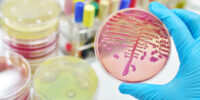Also known as the traffic light reaction, indigo carmine produces a colorful demonstration
In this activity, a redox indicator (indigo carmine) changes color as a result of electron transfer. The introduction of oxygen through swirling causes the indigo carmine to turn green as it is oxidized.
Upon standing, the indigo carmine is reduced by the glucose, causing the indicator to turn yellow. A semiquinone intermediate causes a red color between the yellow and green. You can influence the rate at which the color changes. Higher temperatures and greater concentrations cause the color change to occur more rapidly.
Topics covered: oxidation-reduction reactions, reversible reactions, indicators, rates of reactions
Safety
Use caution when swirling solutions with indigo carmine. This dye will stain skin and clothing. To prevent spills, place a solid rubber stopper in the flask and press downward with the palm of your hand while swirling the flask to add oxygen.

Materials (per demonstration)
-
Glucose, 7.5 g
-
Sodium Hydroxide, 3.75 g
-
Water, Distilled or Deionized, 500 mL
-
Graduated Cylinder, 100 mL
-
Balance
-
2 Stirring Rods
-
2 Beakers 600 mL
-
Erlenmeyer Flask or Bottle, 1,000 mL
Preparation
-
In a 600-mL beaker add 7.5 g of glucose to 375 mL of water. Stir the mixture until the glucose is dissolved.
-
Add a very small amount of indigo carmine to the glucose and water mixture. The solution will turn dark blue.
-
In another 600-mL beaker add 3.75 g of sodium hydroxide to 125 mL of water. Stir the mixture until the sodium hydroxide is dissolved.
Procedure
-
Pour the sodium hydroxide solution into the 1,000-mL Erlenmeyer flask.
-
Add the glucose solution to the flask. Swirl them to mix. The solution should turn green.
-
Allow the solution to rest. It should turn a yellow or red color. If the solution is yellow and you would like to have it change from red to green, swirl it very gently until it starts to change color.
- Once the solution is red, swirl it vigorously to get it to change to green. Upon resting, the solution will again turn yellow or red.
Additional Reading: Investigating Phenomena: What Is Elephant Toothpaste




